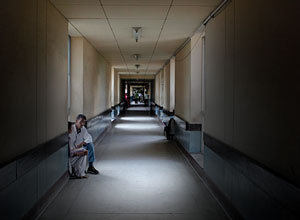 BIKRAM RAI |
Nepal's ratio of doctors to patients is improving, but is still the worst in Asia: there are only two doctors for every 10,000 population, compared to 60 per 10,000 in Cuba. And even these doctors are concentrated in the cities.
Retention of qualified medical staff in rural Nepal has always been a problem in a country where most doctors and nurses either migrate to the capital, or go abroad.
The reasons are fairly obvious: better pay and facilities attract doctors who have to recoup the huge investments they make in financing their medical education.
Now, a new study by a group from the Kathmandu-based Nick Simons Institute (NSI) published in this week's British Medical Journal analyses data of the graduates of the Tribhuvan University's Institute of Medicine to find out what makes a Nepali doctor practice in rural Nepal instead of moving to Kathmandu or migrating abroad.
The study has looked at criteria like gender, age, birthplace, or pre-medical education of 436 of the 727 graduates of the Institute between 1983-2004 to see if there is a pattern in their decision to serve in rural areas. The study found that 27 per cent of the graduates worked outside Kathmandu, 37 per cent practiced medicine in Kathmandu and 36 per cent of the doctors had gone abroad. Of these, three-quarters were in the United States, eight per cent were in the UK, with the others scattered in Australia, South Africa and other countries.
'Doctors graduating in later years were more likely to practice in foreign countries and less likely to practice in rural Nepal,' the paper states, adding that male students made up 88.3 per cent of all graduates and were more likely to remain in Nepal and work in rural areas than their female classmates.
The research paper was prepared by the NSI's Mark Zimmerman, Rabina Shakya, Bharat Pokhrel, Basista Rijal, Ritendra Shrestha and Arun Sayami of the Institute of Medicine and Nir Eyal of the Harvard Medical School.
The findings also show that those with pre-medical education as paramedics were twice as likely to be working in Nepal and 3.5 times as likely to be in rural Nepal, compared with students with a college science background. Also, medical students whose grades were in the lowest third of the class were doubly more likely to be working in rural areas than those with higher marks. Medical graduates born in rural areas and older graduates were both more likely to stay in Nepal and work in the districts.
'Policy makers in medical education who are committed to producing doctors for underserved areas of their country could use this evidence to revise their entrance criteria for medical schools,' the report concludes. 'Selecting students with this background does not guarantee eventual rural practice, but it seems to increase the likelihood.'
Although the proportion of Nepali graduates of the Institute of Medicine who migrate abroad is quite high, things are not as bad as in Ghana where three-quarter of all graduates leave the country after graduation. The paper shows that putting more emphasis on rural birthplace, rural education and a paramedical background rather than on high entrance scores in medical school exams may favour retention of doctors in Nepal.
The government's Institute of Medicine was set up in 1978 to train doctors to serve in the remote rural areas of the country. However, over the years with the advent of private medical schools the emphasis has changed.
Although set up before the NSI study came out, the Patan Academy of Health Sciences (PAHS) has been trying out a novel approach to ensure that its graduates serve in the districts by changing the philosophy of its curriculum.
Sixty per cent of those enrolled in the batch that will be graduating in 2016, for instance, are from underprivileged families mainly from rural areas. Their scholarships require them to work for two to four years in the districts during medical school. If they don't, they won't get to graduate.
The students will be posted to remote area hospitals every six months for two weeks each so they get over their fear of the unknown, and get to see how they can make a difference right from the start of their training. PAHS hopes that this will improve retention of doctors in rural Nepal.
PAHS selects 60 students from over 2,000 applicants, choosing those with personal qualities that ensure more compassionate and empathetic physicians will enter the public health system. Private and government medical schools produce 1,500 doctors each year, but half of them migrate overseas and the ones that stay choose to work in urban areas.
Kunda Dixit
Read the full report of the NSI study in the British Medical Journal
WHERE ARE THEY NOW?
More than a third of the doctors who graduated from the government's Institute of Medicine now work abroad. Breakdown by country:
188 United States
20 United Kingdom
8 Australia
8 South Africa
7 China
4 Canada
4 Japan
2 Bangladesh
2 India
2 New Zealand
2 Sweden
9 Others
Read also:
A nation's health, EDITORIAL
Selecting medical school applicants with district backgrounds and who have worked their way up as paramedics improves chances of doctors serving in rural Nepal
In an ailing state, ANURAG ACHARYA
If this is the state of city hospitals, imagine what it is like in rural areas
Public participation in public health, BHRIKUTI RAI in KAILALI
Communities in western Nepal act to improve local governance and healthcare
See also:
Missionary zeal, MICHAEL COX
New Nepal medical school aims to motivate students to serve in rural areas


